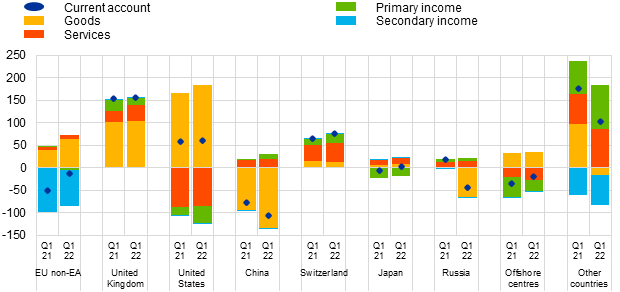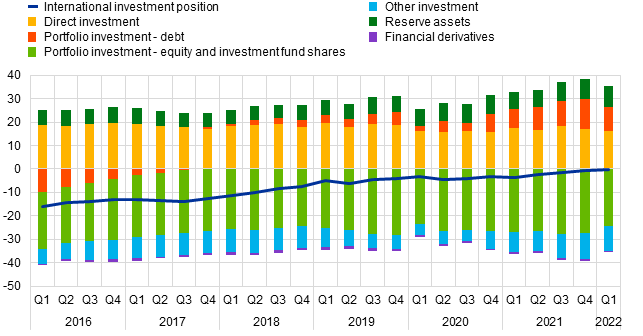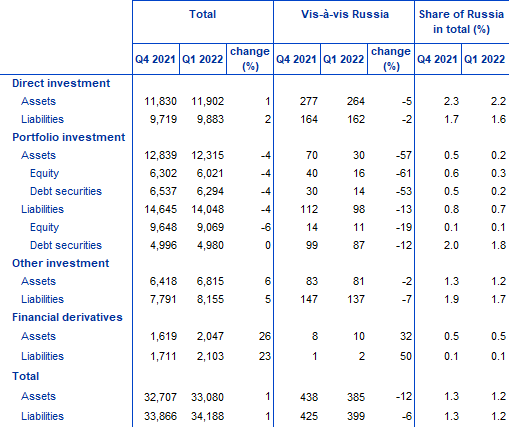- STATISTICAL RELEASE
Euro area quarterly balance of payments and international investment position:
first quarter of 2022
5 July 2022
- Current account surplus at €217 billion (1.7% of euro area GDP) in four quarters to first quarter of 2022, down from €301 billion (2.6% of GDP) a year earlier
- Geographic counterparts: largest bilateral current account surpluses vis-à-vis United Kingdom (€156 billion) and Switzerland (€77 billion), largest deficits vis-à-vis China (€106 billion) and Russia (€44 billion)
- International investment position showed net liabilities of €6 billion (0.04% of euro area GDP) at end of first quarter of 2022
- Euro area financial assets vis-à-vis Russia amounted to €385 billion (1.2% of euro area external assets) at end of first quarter of 2022, down by 12% since end of previous quarter
Current account
The current account surplus of the euro area decreased to €217 billion (1.7% of euro area GDP) in the four quarters to the first quarter of 2022, down from €301 billion (2.6% of GDP) a year earlier (Table 1). This decrease reflected a lower surplus for goods (from €358 billion to €193 billion) that was partly offset by increases in the surpluses for services (from €65 billion to €109 billion) and for primary income (from €42 billion to €64 billion), and a smaller deficit for secondary income (from €164 billion to €148 billion).
The larger surplus for services was due mainly to increases in the surpluses for telecommunication, computer and information services (from €103 billion to €132 billion), transport services (from €2 billion to €17 billion) and travel services (from €9 billion to €24 billion). These developments were partly offset by larger deficits for other services (from €21 billion to €28 billion) and other business services (from €41 billion to €46 billion).
The larger surplus for primary income was due primarily to an increase in the surplus for investment income (from €10 billion to €36 billion), reflecting mainly larger surpluses for direct investment income (from €20 billion to €38 billion) and portfolio debt income (from €40 billion to €48 billion).
Table 1
Current account of the euro area

Source: ECB.
Notes: “Equity” comprises equity and investment fund shares. Discrepancies between totals and their components may arise from rounding.
Data for the current account of the euro area
Data on the geographic counterparts of the euro area current account (Chart 1) show that, in the four quarters to the first quarter of 2022, the euro area recorded its largest bilateral surpluses vis-à-vis the United Kingdom (€156 billion, up from €154 billion a year earlier), Switzerland (€77 billion, up from €66 billion) and the United States (€61 billion, up from €58 billion). It also recorded a current account surplus vis-à-vis a residual group of other countries (€102 billion, down from €176 billion). The largest bilateral deficits were recorded vis-à-vis China (€106 billion, up from €78 billion), Russia (€44 billion, following a surplus of €18 billion) and offshore centres (€19 billion, down from €36 billion).
The most significant geographic changes in the components of the current account in the four quarters to the first quarter of 2022 relative to the previous year were as follows. In goods, the deficit vis-à-vis Russia increased from €1 billion to €65 billion, mainly on account of higher prices for imported energy products. The goods deficit vis-à-vis China also increased, from €95 billion to €134 billion. Moreover, the goods balance vis-à-vis the residual group of other countries turned from a surplus of €97 billion to a deficit of €16 billion, while larger surpluses were recorded vis-à-vis the EU Member States and EU institutions outside the euro area (up from €39 billion to €65 billion) and the United States (up from €166 billion to €185 billion). In services, the surplus vis-à-vis the United Kingdom increased (from €25 billion to €35 billion), as it did vis-à-vis the residual group of other countries (from €67 billion to €87 billion). In primary income, a larger deficit was recorded vis-à-vis the United States (up from €18 billion to €38 billion), while the deficit declined vis-à-vis offshore centres (down from €45 billion to €25 billion) and the surplus widened vis-à-vis the residual group of other countries (up from €74 billion to €98 billion). In secondary income, the deficit vis-à-vis the EU Member States and EU institutions outside the euro area decreased from €99 billion to €80 billion.
Chart 1
Geographical breakdown of the euro area current account balance
(four-quarter moving sums in EUR billions; non-seasonally adjusted)

Source: ECB.
Note: “EU non-EA” comprises the non-euro area EU Member States and those EU institutions and bodies that are considered for statistical purposes as being outside the euro area, such as the European Commission and the European Investment Bank. “Other countries” includes all countries and country groups not shown in the chart, as well as unallocated transactions.
Data for the geographical breakdown of the euro area current account
International investment position
At the end of the first quarter of 2022, the international investment position of the euro area recorded net liabilities of €6 billion vis-à-vis the rest of the world (0.04% of euro area GDP), down from €102 billion in the previous quarter (Chart 2 and Table 2).
Chart 2
Net international investment position of the euro area
(net amounts outstanding at the end of the period as a percentage of four-quarter moving sums of GDP)

Source: ECB.
Data for the net international investment position of the euro area
The €97 billion decline in net liabilities reflected large but partly offsetting changes in the various investment components. Lower net liabilities were recorded in portfolio equity (down from €3.3 trillion to €3.0 trillion) and in other investment (down from €1.4 trillion to €1.3 trillion), while net assets declined for portfolio debt (down from €1.5 trillion to €1.3 trillion) and for direct investment (down from €2.1 trillion to €2.0 trillion).
Table 2
International investment position of the euro area
(EUR billions, unless otherwise indicated; amounts outstanding at the end of the period, flows during the period; non-working day and non-seasonally adjusted)

Source: ECB.
Notes: “Equity” comprises equity and investment fund shares. Net financial derivatives are reported under assets. “Other volume changes” mainly reflect reclassifications and data enhancements. Discrepancies between totals and their components may arise from rounding.
Data for the international investment position of the euro area
The developments in the euro area’s net international investment position in the first quarter of 2022 were driven mainly by positive net flows owing to price changes, exchange rate changes and, to a lesser extent, transactions, which were partly offset by negative net other volume changes (Table 2 and Chart 3).
The decrease in net liabilities for portfolio equity was driven mainly by price changes, as prices in portfolio equity liabilities decreased more than those on the asset side, as well as positive net flows for transactions and exchange rate changes that were partially offset by negative net other volume changes (Table 2). The decline in net assets for portfolio debt resulted from negative net flows in price changes, transactions and other volume changes that were partially offset by positive net exchange rate changes. The decline in net assets for direct investment resulted mainly from negative net flows in price changes and other volume changes that were partially offset by positive net flows for exchange rate changes and transactions. The slight decrease in net liabilities for other investment was driven mainly by positive net transactions.
At the end of the first quarter of 2022 the gross external debt of the euro area amounted to €16.4 trillion (around 131% of euro area GDP), up by €426 billion compared with the previous quarter.
Chart 3
Changes in the net international investment position of the euro area
(EUR billions; flows during the period)

Source: ECB.
Note: “Other volume changes” mainly reflect reclassifications and data enhancements.
Data for changes in the net international investment position of the euro area
This release provides an overview of the euro area’s international investment position vis-à-vis residents of Russia at the end of the first quarter of 2022 and reports the main changes compared with the previous quarter (Table 3).[1] Euro area financial assets vis-à-vis Russia amounted to €385 billion (1.2% of euro area external assets) at the end of the first quarter of 2022, a 12% decline since the end of the previous quarter. This drop was due mainly to euro area holdings of portfolio investment securities issued by residents of Russia, which decreased by 57% in the first quarter of 2022, largely on account of negative price revaluations. At the same time, the euro area recorded liabilities of €399 billion vis-à-vis Russia (1.2% of total external liabilities), a fall of 6% due mainly to a reduction in Russian holdings of euro area portfolio investment securities.
Table 3
International investment position of the euro area – geographical breakdown vis-à-vis Russia
(as a percentage of the total, unless otherwise indicated; at the end of the period; non-working day and non-seasonally adjusted)

Source: ECB.
Notes: “Equity” comprises equity and investment fund shares. “Total assets/liabilities” refer to the sum of direct investment, portfolio investment, other investment and financial derivatives. Reserve assets are not included in the total and financial derivatives are reported separately in gross terms under assets and liabilities. Discrepancies between totals and their components may arise from rounding.
Data for the international investment position of the euro area – geographical breakdown
Data revisions
This statistical release incorporates revisions to data for the reference periods between the first quarter of 2018 and the fourth quarter of 2021. The revisions reflect revised national contributions to the euro area aggregates as a result of the incorporation of newly available information.
Next releases
- Monthly balance of payments: 20 July 2022 (reference data up to May 2022)
- Quarterly balance of payments and international investment position: 5 October 2022 (reference data up to the second quarter of 2022)
For queries, please use the Statistical information request form.
Notes
- Data are neither seasonally nor working day-adjusted. Ratios to GDP (including in the charts) refer to four-quarter sums of non-seasonally and non-working day-adjusted GDP figures.
- Hyperlinks in this press release lead to data that may change with subsequent releases as a result of revisions.
Table 3 does not include reserve assets in the total euro area external asset positions and financial derivatives are reported in gross terms instead on net terms (Table 2).


